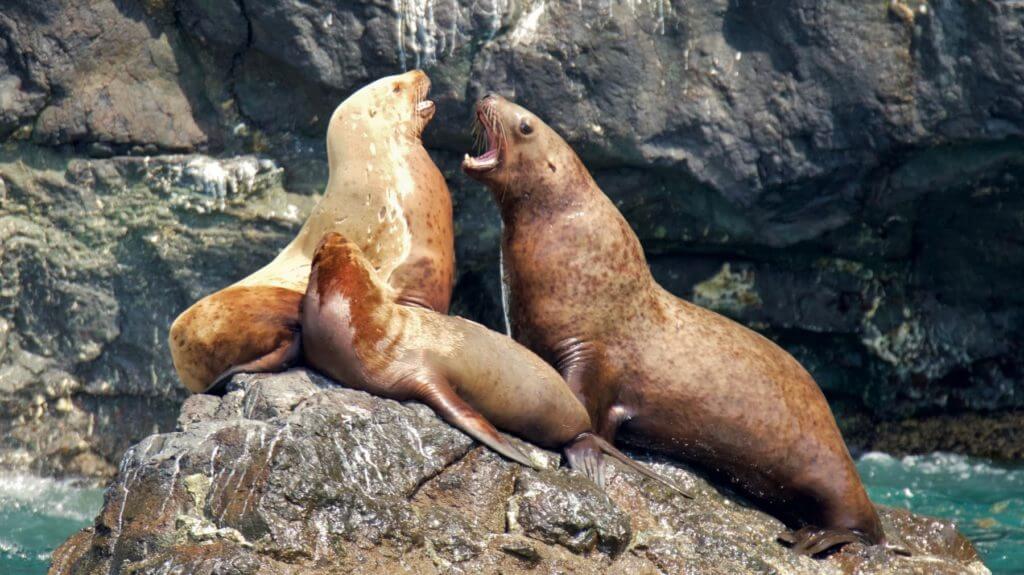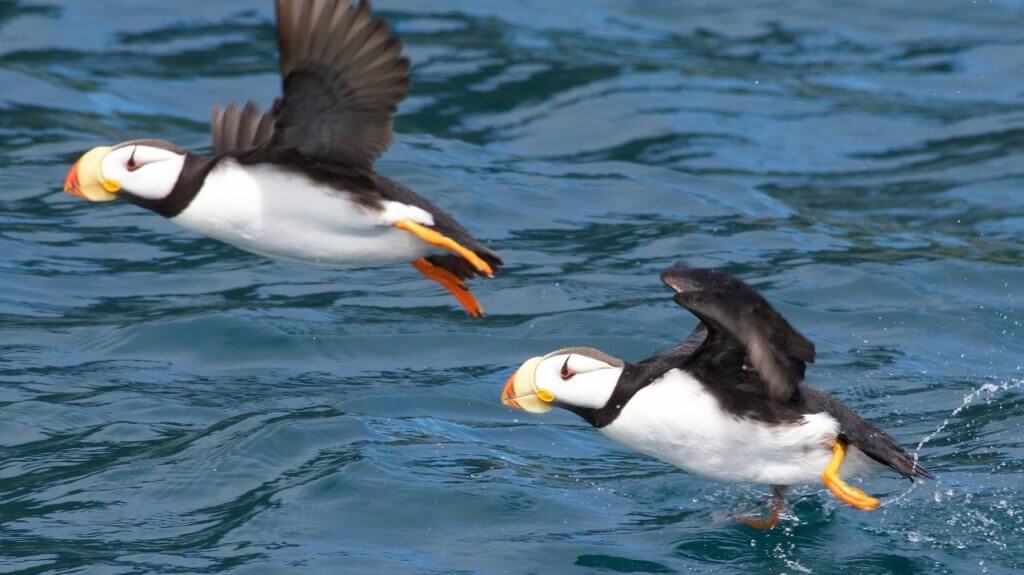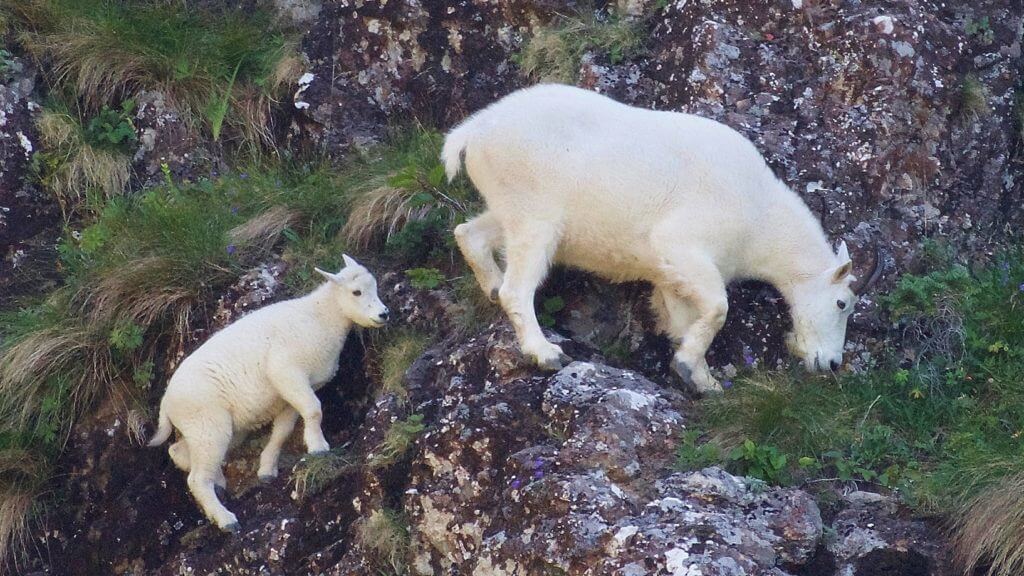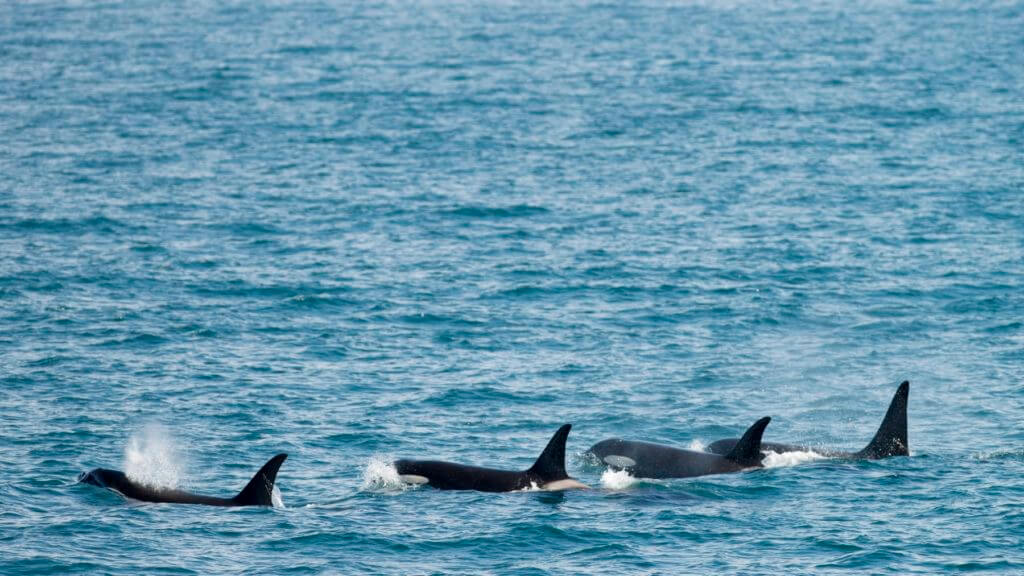Most visitors to Alaska get to embark on a glacier and wildlife cruise just once. But what would it be like to cruise day after day? Our guest blogger Tamara Lang, a Major Marine Tours deckhand and interpretive volunteer at Kenai Fjords National Park, gets to do just that. Here are her accounts of what it’s like to view wildlife on Major Marine Tours cruises from Seward all summer long.I watched as the orca’s fin rose into the mash of sound where white kittiwakes wheeled from the cliffs, shaping music in massed wings. Across our bow, humpbacks hung their misty blows before dipping down into the clouds of silver fish. A raft of common murres lifted shoulders and dove, erasing themselves. White drops on glacier-carved cliff materialized into mountain goats as puffins splashed color below. Then the orca slid back up from the sea and I stood wrapped in awe on the bow of the Glacier Express, unable to move in the face of such extravagant life.
There is a reason that the Kenai Fjords near Seward, Alaska draw humpback visitors from far-off Hawaii and human visitors from even greater distances, and that reason comes written into the color of the waves. As days lengthen around cold, nutrient-rich seas, Alaskan waters explode into a flurry of life. Nowhere is that life framed quite so beautifully as onboard Major Marine Tours vessels departing into the fjords, where between the glaciers, animal richness comes embodied in the shapes of humpback whales, puffins, Steller sea lions, mountain goats, seabirds, and the ever-loved orca.
Humpback Whales
En route to the glacier on the 6 Hour Kenai Fjords National Park Cruise I stood on the bow of the Spirit of Adventure, surrounded by the blows of humpback whales.
“Blow at one o’clock,” the ranger announced, and then a second later, “eleven o’clock and nine o’clock as well.”
I stood weightless and breathless, sharing silence with the hushed anticipation of those on the bow, our eyes glancing ahead toward the next blow. A murmur moved across the bow with the heavy rise of body beneath pale breath, and then the whale arched, silent, his fluke rising noiselessly as water poured back into the sea.
As days lengthen in Seward, humpback whales return to Alaska from their winter breeding grounds in Hawaii, concluding a round-trip journey of nearly 6,000 miles that stands as one of the longest mammal migrations worldwide. In Kenai Fjords, they are met with clouds of krill or schooling fish vast enough to provide fuel for the next year’s migration. And this is where the magic happens, as the humpback whale sculpts its ocean world, smashing the waves with its powerful tail, spiraling graceful pectoral fins into the air, and even soaring into the air in a mind-numbing breach. No marine mammal can compare to the humpback’s elegance, especially in the moments when his underwater world of twists and trailing fins erupts from the surface in an overwhelming display of mass turned weightless.
While any of the Major Marine Tours cruises provide a good chance of viewing humpback whales, the 6 Hour Kenai Fjords National Park Cruise travels through prime humpback waters.

Steller Sea Lions
The guttural roar of the Steller sea lions reverberated across the deck of the Star of the Northwest on the 5 Hour Kenai Fjords Wildlife Cruise, echoing between blue waves and the soft domes of pillow basalt where white kittiwakes wheeled out across the water to confuse the eye of the bald eagle soaring above. I leaned into the window behind the click of cameras, awed by the awe these creatures inspired. A male stretched just above the sea spray, massive and solid, his roar carving its way deep into my chest.
Discovered by William Steller in 1741, these animals were the first to be named the lions of the sea, and looking at the golden silhouette of a thick-necked male against the dark cliffs the comparison made perfect sense. Male Steller sea lions can reach 2,500 pounds, earning them the title of the largest of all sea lions, and their size shows. A camera from the Seward Sealife Center testified to the precarious place these sea lions held in the face of their extreme population decline, but standing amidst their roars above the wave-rubbed rocks, these giants of the ocean showed themselves worth protecting.
Steller sea lions are a daily highlight of the 5 Hour Kenai Fjords Wildlife Cruise, and can also be seen on all of our other tours.

Puffins
On the Orca Song’s 3.5 Hour Kenai Fjords Wildlife Cruise I glimpsed a splash of orange and black dashing against the textured clouds, and smiled up into the shape of a horned puffin in flight. Around us clouds tore off the treeline, and water sat cloaked in a multi-hued grey, yet in the midst of this motion the puffin appeared as color condensed. Wings familiar with underwater flight battled thin air, offering a glimpse into the underwater world where the puffin flew through clouds of silver fish beneath a sky of waves lit by sun. Then the puffin continued his painted flight, and the Orca Song moved on into our own world of rippled mountains.
More at home at sea than on land, horned and tufted puffins nonetheless return to the coastline of Resurrection Bay each summer to change out drab winter feathers for their breeding best. Throughout the summer they converge on and above rocky cliff faces, nestled among the wildflowers in their jewel-like garb, but ultimately the sea is their home. Bright with dense color, they are best seen above the shifting waves.
Puffins may be seen on any of our trips, and the 3.5 Hour Kenai Fjords Wildlife Cruise offers a prime possibility of seeing these birds.

Mountain Goats
The wildlife of Alaska does not end at the shore, and the sheer cliff faces of the Fjords allow the bizarre experience of viewing mountainous wildlife from the deck of a boat. On one such occasion I stood on the Glacier Express below Aialik glacier on a sunny 7.5 Hour Kenai Fjords National Park Cruise, watching ice calve away from the bright face of the glacier as the ice cracked sound with the density of a rifle shot, when my eyes caught at three specks of an entirely different type of white easing along the cliffs. Looking closer, I saw two adult mountain goats moving along a rocky cleft. A kid frolicked beside them, racing up the grassy slope. Beside the whimsical barrenness of the calving glacier the goats moved through slopes of vivid green, while to port, a harbor seal slipped off his raft of ice and into still water. Alaska, it seems, does not accept barriers, and we stood below the cliffs as sea and land and ice and sky combined into one bright image of abundance.
While mountain goats might be seen on any of our trips, the 7.5 Hour Kenai Fjords National Park Cruise takes you past the greatest amount of coastline.

Kittlitz’s Murrelet
I stood on the bow of the Viewfinder, staring hard into the water near the base of Northwestern Glacier.
“There,” the man beside me said, and raised his binoculars toward a small bird in flight. “That’s it,” he said, “that’s a Kittlitz’s,” his excitement too concentrated to emerge in something so trivial as a smile.
I looked back toward the small, sharp body of the Kittlitz’ Murrelet, a bird whose unassuming appearance masked its extreme rarity to human eyes. Found only in the waters where glaciers meet the sea, this bird exists on the brink of a rapidly changing environment. Less than twenty of its nests have ever been described by science. The Kittlitz’s murrelet joins the red-faced cormorant and a flurry of auklet species in making Kenai Fjords National Park a natural space for the hushed anticipation of world-class birding.
While seabirds can be viewed on any of our trips, the 8.5 Hour Northwestern Fjord Cruise is by far the best way to experience the full number of species that make the Kenai Fjords home.
Orca
The first time in my life that I ever saw an orca, I stood on the bow of the Glacier Express with my hands clasping the railing, staring into the hung stillness of a tall blow above a glassy bay. A tall dorsal fin slid slowly into the water, rippling the reflection of the rugged coastline around its absence. Nobody on the bow dared to speak. I could feel the anticipation pillowing the deck, wrapping itself into each breath, brightness leaving the water’s surface to settle in our waiting eyes. The fin rose, and the sound of his blow settled into the static of our watching. With each breath he speared the still surface, his fin tall and straight, closer and closer until he was almost beneath our silent boat, and then my breath caught as he dipped long and slow directly beneath me. Space spun under, caught at the meeting of my world and his, as his sleek body and white saddle took on the opposite of my own stance on the bow and I stared hard into the meeting of our two worlds, tied together by the boat beneath my feet.
From plankton to orca, the wildlife of Resurrection Bay and Kenai Fjords National Park outpaces all of my expectations. Here, biodiversity comes written in color and framed beneath the face of calving glaciers. And when standing on the bow of a Major Marine Tours vessel above the shadow of an orca, life truly becomes wild.

Tamara Lang is a writer of Creative Nonfiction, an interpretive volunteer at Kenai Fjords National Park, and a deckhand with Major Marine Tours in Seward, Alaska. Read more of her work at tamaralang.com, or follow tamaralangwrites on facebook or instagram.
Signup for our newsletter to get the most recent Major Marine updates.